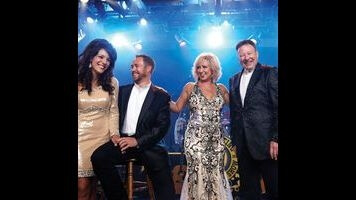Branson Famous is reality TV in the uncanny valley

The appeal of trashy non-competitive reality TV shows—and the thing that makes them such an easy target for cheap jabs—is the way everything in these shows ends up snapping into an over-familiar pattern of first-person-present interviews, exaggerated meltdowns, and manufactured conflict. Of course it’s all fake—but why shouldn’t it be? Fake isn’t necessarily bad; it has its place.
Branson Famous, however, falls in the uncanny valley of reality-TV fakeness. On the one end you have your run-of-the-mill reality shows, which are ostensibly non-fictional, but emotionally fake; on the other, you have honest-to-God scripted drama, which is overtly fictional, but can feel emotionally real. And somewhere in the gulf between the two is Branson Famous, a show that pushes the barely concealed behind-the-scenes fussing of reality TV to its breaking point.
Branson Famous is billed as the TV’s first “reality musical,” which essentially means that its leads occasionally break into song, and not in the singing competition sense. They sing arguments, interview asides, mid-episode backstories—all of the stuff that distinguishes reality TV as a genre. They sing directly to the camera, in chin-to-forehead close-up, their eyes creepily locked on the viewer. The songs are country-karaoke Brechtian alienation effects. They’re also ear-splittingly terrible, but that’s almost beside the point.
And yet, these musical interludes are easily the most interesting thing about Branson Famous, which is otherwise the definition of a bottom-of-the-barrel reality show. Its stars are the Mabe family, who run The Baldknobbers Jamboree Show, one of the oldest variety revues in that surreal, sleepy strip of billboards, theaters, and themed motels at the bottom of the Ozarks: Branson, Missouri.
Branson is the $10 rhinestone bald-eagle sweatshirt of American cities, home to Biblical musicals, competing tribute bands, oldies acts without any original members, and the Titanic Museum, which is shaped like bow of the ship, and is entered through the iceberg. Not that any of that is in Branson Famous’ pilot. These kinds of reality shows are, by design, uncurious and anti-documentary, and the fun of watching them is all in the artificial tension—real people and real lives getting chopped down into “I’m not here to make friends” archetypes and simple arcs. Actually, calling reality show stars real might be a stretch, because ordinary people don’t star in reality shows—only aspiring reality stars do. At this point, no one watches reality shows to get a glimpse of ordinary life caught unawares; they watch them to see wannabe stars perform for the camera, often poorly and cynically.
Which brings us to the Mabes and back to those bizarro song interludes. The piece de resistance of the Branson Famous pilot is an argument between Mabe matriarch Patty and her son’s girlfriend, Megan, who is the Baldknobbers’ other female vocal soloist. (Ostensible Mabe head-of-household Tim—who performs onstage as a hillbilly-teeth clown named Droopy Drawers—barely appears in the pilot, and then only out of costume, as though the show were ashamed of the Baldknobbers’ star attraction.) Patty’s son, Brandon, left his wife for Megan sometime before the start of filming, which creates a convenient real-world tension for Branson Famous to work off of, as do the Baldknobbers’ troubled finances, which they hope to resolve with the help of investor Inderjit Grewal, whose first name the Mabes pronounce with a kind of over-enunciation that suggests that they’re never sure whether they’re getting it right.
So Patty and Megan start arguing in that familiar reality-show way, making passive-aggressive comments to each other within sight of the camera crew, and then expanding on them in faux-candid, sit-down, direct-to-camera interviews, which are intercut with the argument and exaggerated with stock musical strings. There’s a great phrase for snappy comebacks you only think of hours after the fact: staircase wit. Reality shows, competitive and non-competitive alike, are the domain of staircase wit, and the fact that Branson Famous’ faux-candids are shot in front of a spotlit theater-curtain backdrop makes it seem all the more rehearsed and performative.
Patty and Megan are both wearing Versailles-sized hairdos and half-inch layers of makeup, which make them look as though they’re performing the Ozarks family argument equivalent of ritualized theater—countrified kabuki. And then their spotlit staircase-wit interview-selves—who are even more made-up—start singing, and soon the sequence turns into a split-screen duet about how much they don’t like each other. The moment would be endearingly goofy, if it weren’t also so cynical.
And that’s the problem here, because it underscores the fact that Branson Famous isn’t some kind of scripted-unscripted hybrid, but just a musical soap opera whose stars happen to be playing themselves. So-called unscripted shows are fun because they’re only tenuously real, but a show that registers as completely scripted—that is, completely artificial—simply comes across as bad drama. And that’s all Branson Famous is: a scripted show with ugly camerawork, awkward musical numbers, and a cast of over-emoting unknowns playing one-dimensional stereotypes.